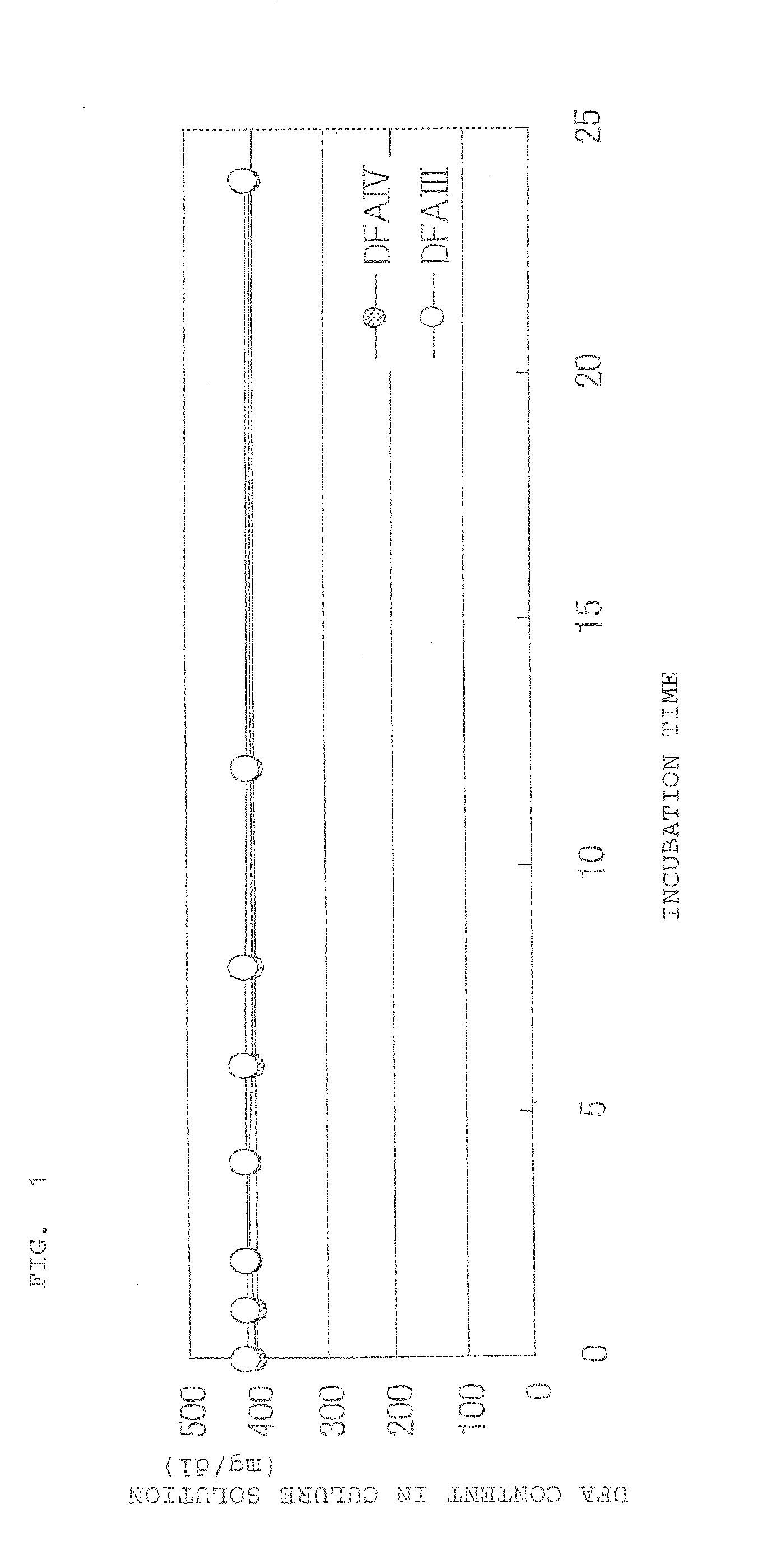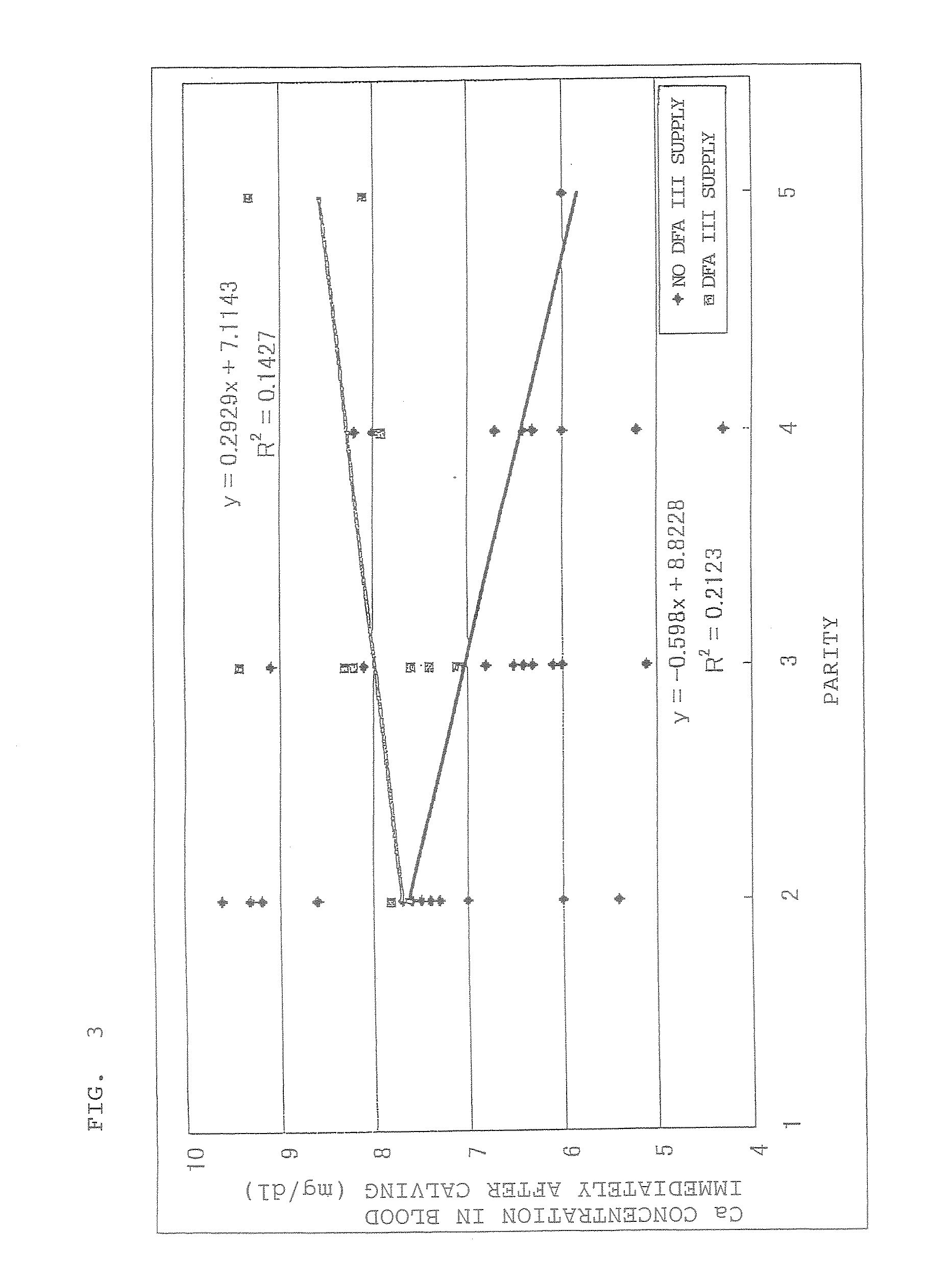Preventive and/or therapeutic agent for calcipenia
a technology of calcipenia and therapeutic agents, which is applied in the direction of drug compositions, extracellular fluid disorders, metabolic disorders, etc., can solve the problems of inability to provide satisfactory results, injuring the health, and actually quite difficult to ingest a satisfactory amount of calcium, so as to improve lactation, improve lactation, and reduce the effect of periparturient diseases
- Summary
- Abstract
- Description
- Claims
- Application Information
AI Technical Summary
Benefits of technology
Problems solved by technology
Method used
Image
Examples
example 2
[0097]The effect of supply of DFA III and DFA IV on calcium metabolism, lactation and a urine excretion amount of cows was examined.
[0098]Nine Holstein cows (2 to 4 calvings, 90 to 120 days after calving, average body weight 642 kg, average milk yield 36 kg) were divided into three groups, and subjected to a test by 3×3 Latin squares with one period of 15 days (preliminary period of 10 days and main period of 5 days).
[0099]Regarding supplied feeds for a day, a grass silage, a cone silage and a beat pulp were used in fixed amounts of 3, 4 and 2 kg in terms of a dry weight respectively, and an amount of a concentrate (crude protein content 18% TDN content 74%) was ⅓ the milk yield. Further, a mineral agent and a vitamin agent were not supplied, and an insufficient feed for each cow was supplemented by supplying hay. These supplied feeds have the same contents in all cows, and they were caused to freely drink water.
[0100]The foregoing supply only was applied to a control group Supplied...
example 3
[0104]The influence of DFA III and DFA IV on the calcium concentration in blood in calving of cows was examined.
[0105]As test cows, 15 Holstein calving cows with two or more calvings were used, and divided into three groups each consisting of 5 cows. Immediately after calving, the blood was sampled from the tail root. 300 ml of warm water was orally administered to the control group. 100 g of DFA III and 100 g of DFA IV each dissolved in 250 ml of warm water were orally administered to the DFA III group and the DFA IV group respectively. The blood was sampled from the tail root after 6 hours and 60 hours from the blood sampling immediately after calving. The degree of the udder edema was also confirmed by palpation.
[0106]Regarding the feeds supplied after calving, the cows were caused to freely take 20 kg / day of TMR containing a grass silage, a corn silage and a concentrate (hereinafter referred to as a mixed feed: forage rate 47.8%), 4 kg of a concentrate and hay. The contents of s...
example 4
[0110]The effect of DFA III and calcium and vitamin D on the calcium concentration in blood at the time of calving of cows was examined.
[0111]As test cows, 15 Holstein calving cows with 2 or more calvings were used, and divided into three groups each consisting of 5 cows. Immediately after calving, the blood was sampled from the tall root. 100 g of DFA III dissolved in 250 ml of warm water was orally administered to the DFA III group. DFA III and calcium carbonate in amounts of 100 g each which were dissolved in 200 ml of warm water were orally administered to the DFA III+Ca group. DFA III and calcium carbonate in amounts of 100 a each and 10,000 IU of vitamin D which were dissolved in 200 ml of warm water were orally administered to the DFA III+Ca+VD group. The blood was sampled from the tail root after 6, 24 and 70 hours from the blood sampling immediately after calving.
[0112]The supply of the feeds and the analyses of the calcium concentration in blood were conducted in the same ...
PUM
| Property | Measurement | Unit |
|---|---|---|
| Time | aaaaa | aaaaa |
| Mass flow rate | aaaaa | aaaaa |
| Concentration | aaaaa | aaaaa |
Abstract
Description
Claims
Application Information
 Login to View More
Login to View More - R&D
- Intellectual Property
- Life Sciences
- Materials
- Tech Scout
- Unparalleled Data Quality
- Higher Quality Content
- 60% Fewer Hallucinations
Browse by: Latest US Patents, China's latest patents, Technical Efficacy Thesaurus, Application Domain, Technology Topic, Popular Technical Reports.
© 2025 PatSnap. All rights reserved.Legal|Privacy policy|Modern Slavery Act Transparency Statement|Sitemap|About US| Contact US: help@patsnap.com



